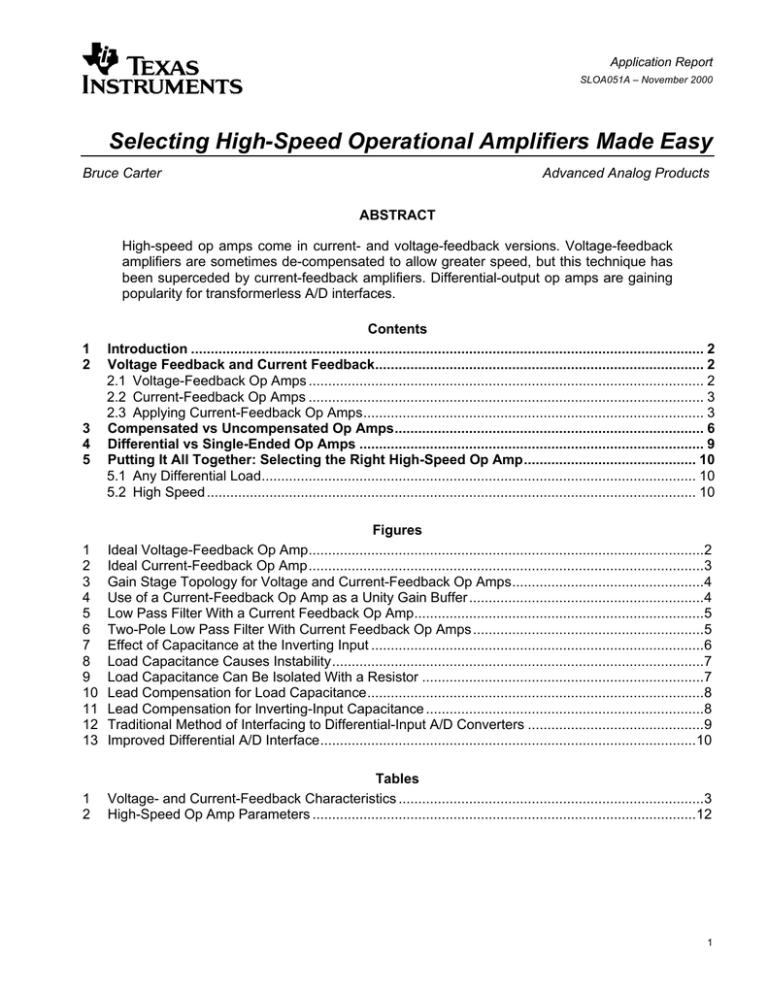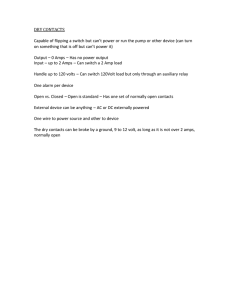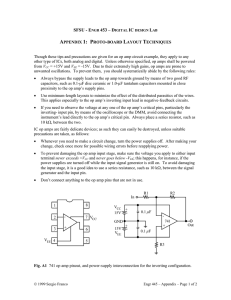Selecting High-Speed Operational Amplifiers
advertisement

Application Report SLOA051A – November 2000 Selecting High-Speed Operational Amplifiers Made Easy Bruce Carter Advanced Analog Products ABSTRACT High-speed op amps come in current- and voltage-feedback versions. Voltage-feedback amplifiers are sometimes de-compensated to allow greater speed, but this technique has been superceded by current-feedback amplifiers. Differential-output op amps are gaining popularity for transformerless A/D interfaces. 1 2 3 4 5 Contents Introduction ................................................................................................................................... 2 Voltage Feedback and Current Feedback.................................................................................... 2 2.1 Voltage-Feedback Op Amps ..................................................................................................... 2 2.2 Current-Feedback Op Amps ..................................................................................................... 3 2.3 Applying Current-Feedback Op Amps....................................................................................... 3 Compensated vs Uncompensated Op Amps............................................................................... 6 Differential vs Single-Ended Op Amps ........................................................................................ 9 Putting It All Together: Selecting the Right High-Speed Op Amp............................................ 10 5.1 Any Differential Load............................................................................................................... 10 5.2 High Speed ............................................................................................................................. 10 1 2 3 4 5 6 7 8 9 10 11 12 13 Figures Ideal Voltage-Feedback Op Amp.....................................................................................................2 Ideal Current-Feedback Op Amp.....................................................................................................3 Gain Stage Topology for Voltage and Current-Feedback Op Amps.................................................4 Use of a Current-Feedback Op Amp as a Unity Gain Buffer ............................................................4 Low Pass Filter With a Current Feedback Op Amp..........................................................................5 Two-Pole Low Pass Filter With Current Feedback Op Amps ...........................................................5 Effect of Capacitance at the Inverting Input .....................................................................................6 Load Capacitance Causes Instability...............................................................................................7 Load Capacitance Can Be Isolated With a Resistor ........................................................................7 Lead Compensation for Load Capacitance......................................................................................8 Lead Compensation for Inverting-Input Capacitance .......................................................................8 Traditional Method of Interfacing to Differential-Input A/D Converters .............................................9 Improved Differential A/D Interface................................................................................................10 1 2 Tables Voltage- and Current-Feedback Characteristics ..............................................................................3 High-Speed Op Amp Parameters ..................................................................................................12 1 SLOA051A 1 Introduction The availability of high-speed operational amplifiers (op amps) is relatively recent. Most designers are either unaware of the differences between high- and low-speed op amps, or are intimidated by them. This note is written to make the basic concepts of high-speed op amps easy to understand. It is intended as a guide for designers who must specify and use a highspeed op amp. 2 Voltage Feedback and Current Feedback There are two basic types of high-speed op amp[1], voltage and current feedback. A brief review of these types of op amps follows. 2.1 Voltage-Feedback Op Amps The voltage-feedback op amp is familiar to designers. Its ideal form is shown in Figure 1. Figure 1. Ideal Voltage-Feedback Op Amp The gain of an ideal voltage-feedback op amp is given by: VO = a × Ve where VO is the output voltage, a is the open-loop voltage gain, and Ve (= Vp – Vn) is the error voltage. Although no op amp is ideal, modern processing techniques yield devices that come close, at least in some parameters. This is by design. In fact, different op amps are optimized to be close to ideal for some parameters, while other parameters for the same op amp may be quite ordinary. It is a trade-off. Some parameters can be improved, but only at the expense of others. It is the designer’s function to select the op amp that is closest to ideal in ways that matter to the application, and to know which parameters can be discounted or ignored. When dealing with high-speed op amps, the parameters that are of most interest to the designer are bandwidth and slew rate. In voltage-feedback amplifiers, bandwidth is inversely related to gain over the normal operating range of the op amp. This linear relationship is a –20 dB/dec rolloff caused by an internal compensation capacitor. This capacitor was introduced to solve a problem that has plagued voltage-feedback op amps from the time they were first introduced, namely, instability (i.e., the tendency to oscillate). The technique works well, and it has allowed the production of many varieties of voltage-feedback op amps over the years. Unfortunately, the compensation capacitor also limits the response of the op amp at high frequencies. 2 Selecting High-Speed Operational Amplifiers Made Easy SLOA051A 2.2 Current-Feedback Op Amps There is much confusion amongst designers as to exactly what a current-feedback op amp is. The term current feedback refers to the internal construction of the op amp, not to something external to it. The ideal current-feedback op amp is shown in Figure 2. Figure 2. Ideal Current-Feedback Op Amp The gain of an ideal current-feedback op amp is given by: VO = i e Z t where VO is output voltage, ie is the error current, and Zt is the open-loop transimpedance gain. It can be seen in Table 1 that the slew rate of a current feedback op amp is more than an order of magnitude greater than that of a voltage feedback op amp. Table 1. Voltage- and Current-Feedback Characteristics CHARACTERISTIC VOLTAGE FEEDBACK CURRENT FEEDBACK Part number Bandwidth (MHz) THS4001 300 THS3001 420 Slew rate (V/µs) 400 6500 Settling time (ns) I/O (mA) 30 100 40 100 . . Op amp design is a series of trade-offs and an improvement in one parameter is always accompanied by degradation of others. This is certainly the case with current-feedback amplifiers where, to a degree, dc performance has been sacrificed to gain speed. 2.3 Applying Current-Feedback Op Amps It is important to resolve misconceptions about how to use current-feedback amplifiers. The average designer does not know how to build a gain stage with a current-feedback op amp. Usually there is the assumption that something esoteric is done with the traditional, familiar, gain topologies. This is not true. In fact, as shown in Figure 3, there is no difference! Selecting High-Speed Operational Amplifiers Made Easy 3 SLOA051A INVERTING GAIN VOLTAGE FEEDBACK CURRENT FEEDBACK R2 R2 +VCC R1 IN +VCC R1 mA741 - IN + THS3001 - OUT OUT + -VCC -VCC NONINVERTING GAIN VOLTAGE FEEDBACK CURRENT FEEDBACK +VCC +VCC mA741 IN THS3001 IN + + OUT - -VCC -VCC R2 R2 R1 Figure 3. OUT - R1 Gain Stage Topology for Voltage and Current-Feedback Op Amps There are several do's and do not's for current-feedback op amps: first, the do not's: • Do not use a current-feedback op amp as a traditionally configured unity gain buffer (output connected directly to inverting input)! Correct and incorrect unity gain buffers are shown in Figure 4: NO!!! YES +VCC IN +VCC THS3001 + OUT -VCC Figure 4. 4 IN THS3001 + OUT -VCC Use of a Current-Feedback Op Amp as a Unity Gain Buffer Selecting High-Speed Operational Amplifiers Made Easy SLOA051A • Do not connect a capacitor from the output of a current-feedback op amp to the noninverting input. Designers will often do this when trying to implement a low-pass filter. Correct and incorrect ways to implement a low-pass filter with a current-feedback op amp are shown in Figure 5. NO!!! YES +VCC R2 C1 R1 IN THS3001 + +VCC IN R1 - OUT - C1 THS3001 OUT + -VCC R3 R2 -VCC Figure 5. Low Pass Filter With a Current Feedback Op Amp The correct way to implement a two-pole filter is to use the Sallen Key topology, as shown in Figure 6, adding the recommended feedback resistor for the current feedback amplifier. +VCC C1 R1 R2 IN + - C2 THS3001 OUT -VCC Figure 6. Two-Pole Low Pass Filter With Current Feedback Op Amps Along with the do not's, there are some do's: • Do watch the trace length on the inverting input. Capacitance on this input, formed by parasitic capacitance with other layers and traces, will reduce the phase margin (see Figure 7). Selecting High-Speed Operational Amplifiers Made Easy 5 SLOA051A Figure 7. Effect of Capacitance at the Inverting Input Parasitic capacitance comes primarily from PCB traces. Long or wide traces create capacitance with ground planes and adjacent traces. Keep the inverting input trace short. • The current-feedback op amp must have a resistor in the feedback loop. This resistor is usually specified in the data sheet for the device. It is chosen to limit overshoot or undershoot in the output amplitude near the maximum operating frequency. • To change the gain of a current-feedback op-amp circuit, change the input gain resistor, not the feedback resistor. • Do use correct PCB techniques, including a separate analog ground plane for high-speed op amps. • Do use correct decoupling techniques. This includes placing a 10 nF or 100 nF ceramic capacitor less than 0.1” from the power supply pin. 3 Compensated vs Uncompensated Op Amps It is possible to make a high-speed voltage-feedback op amp without a compensation capacitor. Doing so allows the op-amp gain to be semi-independent of bandwidth, but the designer is responsible for externally compensating the op amp. At present, there are very few uncompensated op amps on the market. Many so-called uncompensated op amps actually have compensation capacitors that are smaller than usual, and thus are decompensated partially, albeit not completely. The user must supply additional compensation, trading bandwidth for stability. 6 Selecting High-Speed Operational Amplifiers Made Easy SLOA051A Decompensated op amps have not been widely successful in the market. The newer, currentfeedback amplifiers achieve high speeds without sacrificing stability. Voltage-feedback amplifiers with compensation have also become faster than those decompensated devices that are on the market. Consequently, this note covers decompensated op amps in only general terms. In the event that a decompensated op amp is needed, exact component values can be found in the data book[4] and techniques to derive such values have been discussed by Mancini[2]. All voltage-feedback amplifiers can be made unstable under the right conditions. The techniques described here can usually solve stability problems. The worst enemy of stability is load capacitance (Figure 8). + Figure 8. OUT Load Capacitance Causes Instability Load capacitance is most commonly encountered when interfacing an op amp to a data converter, which can have relatively large variable capacitance at its input. The problem is especially severe in uncompensated (or decompensated) op amps. + Figure 9. OUT Load Capacitance Can Be Isolated With a Resistor The usual method of isolating load capacitance is with a small series resistor (Figure 13). However, this also forms an RC low-pass filter with the cutoff frequency of fO = 1/(2πRC) and, as a consequence, it will limit the frequency response of the circuit and load the amplifier at frequencies above 1/(2πRC). Many times, the A/D manufacturer will specify the component values for this RC circuit. Follow the manufacturer’s recommendations. Unless connection points are supplied to the internal op-amp compensation points, there are very few places at which the designer can apply compensation. The output terminal, as shown in Figure 9, is one such place. Another way to compensate an unstable voltage-feedback op amp is through lead compensation, as shown in Figure 10. Selecting High-Speed Operational Amplifiers Made Easy 7 SLOA051A Rf +VCC Rin IN OUT + -VCC Figure 10. Lead Compensation for Load Capacitance The concept is to balance the phase lag caused by the load capacitance with a phase lead from the feedback capacitance so that the two capacitors effectively cancel each other. Frequency response can actually increase with the correct value of the feedback capacitor. Direct calculation is beyond the scope of this note and, indeed, laboratory experimentation may produce the quickest results. Note that the lead capacitor also works in a noninverting gain circuit. Inverting-input capacitance can cause instability in both voltage- and current-feedback op amps. The problem is especially severe in op-amp circuits with gains of less than one (inverting attenuator circuits). The lead-capacitor technique can also be used to compensate for input capacitance on the inverting input, as shown in Figure 11. Rf +VCC IN Rin + OUT -VCC Figure 11. Lead Compensation for Inverting-Input Capacitance Both load and inverting-input capacitance can contribute to instability, so the lead capacitor should be selected to compensate for both. Note that current-feedback amplifiers are much less tolerant of capacitors in the feedback loop. Place a resistor in series with the feedback capacitor. 8 Selecting High-Speed Operational Amplifiers Made Easy SLOA051A 4 Differential vs Single-Ended Op Amps Differential op amps have been increasing in popularity in recent years. Differential-output op amps actually revive a design concept almost 50 years old. The original vacuum-tube-based op amp, the K2-W, was a differential-output device. The primary application for differentialoutput op amps is interfacing to differential-input A/D converters. +VCC IN THS3201 + - A/D +INPUT A/D COMMON MODE INPUT -VCC Figure 12. A/D -INPUT Traditional Method of Interfacing to Differential-Input A/D Converters Figure 12 shows how differential A/D converters have been interfaced in the past. The differential inputs of the A/D converter are connected through a transformer to a single-ended op amp. There is nothing inherently wrong with this approach, but it does have some disadvantages: • It does not take advantage of the noise rejection possible with differential circuitry. • The circuit does not include dc in the frequency response. By definition, transformer T1 isolates dc and limits the ac response of the circuit. Selecting High-Speed Operational Amplifiers Made Easy 9 SLOA051A 511 W /PD +VCC /PD VCC+ 7 487 W 8 3 5 + A/D +INPUT VOUT- 2 VOCM A/D COMMON MODE INPUT VOUT+ 49.9 W 49.9 W 1 4 - A/D -INPUT VCC- THS4140 6 Vs -VCC 511 W 511 W Figure 13. Improved Differential A/D Interface Figure 13 shows an improved A/D Interface. A differential-output op amp, the THS 4140, has been substituted for the single-ended op amp. This allows the transformer to be eliminated. The main advantage of this circuit is that it includes dc in the frequency range; in other words, it is dc accurate. 5 Putting It All Together: Selecting the Right High-Speed Op Amp With this background, a designer now should be in a better position to make a good decision about which high-speed op amp is right for a given application. In this section, some suggestions are made about which particular op amp to select. The selections are not intended to be exclusive because (a) any application may contain additional constraints that would lead to a better choice, and (b) new devices will become available after publication of this note. 5.1 Any Differential Load For differential loads, use THS413X, THS414X, or THS415X. 5.2 High Speed Table 2 is a guide for the application of high-speed op amps. The best parameters are in bold face type. If your application needs: 10 • A current-feedback op amp: Use 3001 • A dual op amp: All op amps except for the 3001 and 4001 are available in dual packages. Selecting High-Speed Operational Amplifiers Made Easy SLOA051A • Offset trimming: The op amps listed that are available as single devices have nulling inputs, except the THS3001. • To operate from a single 5-V supply: Use 4001. • To drive capacitive loads: Use the 404X. Any op amp can do this if compensated correctly, however. • For video applications: Use 4011. • Low noise: Use 3001, 402X, or 403X. • Fast settling time: Use 4011. • Low THD: Use 3001. • High load drive: Use 6002, 6012, 6022, or 6032. • Low quiescent power consumption: Use 408X. Selecting High-Speed Operational Amplifiers Made Easy 11 12 Table 2. 6500 40 0.01 0.02 100 –96 1.6 6.6 Settling time (ns) Differential gain (%) Differential phase angle (Deg.) Output drive (mA) Distortion dBc 1 MHz, 150 Noise nV/rtHz Quiescent Current per amplifier (mA) 420 Speed (MHz) Slew rate V/µs THS3001 Parameter Selecting High-Speed Operational Amplifiers Made Easy 7.8 12.5 –72 100 0.15 0.04 40 400 270 THS4001 7.8 7.5 –80 110 0.01 0.006 37 310 290 THS4011/2 7.8 1.5 –68 100 0.08 0.02 40 470 350 THS4021/2 8.5 1.6 –72 90 0.03 0.02 60 100 100 THS4031/2 8 14 –75 100 0.01 0.01 120 400 165 THS4041/2 8.5 14 –82 100 0.01 0.01 60 240 70 THS4051/2 7.8 14.5 –72 115 0.02 0.02 40 400 180 THS4061/2 3.4 10 –64 85 0.05 0.01 43 230 175 THS4081/2 SLOA051A High-Speed Op Amp Parameters SLOA051A References: 1. Voltage Feedback vs Current Feedback Op Amps, James Karki, Texas Instruments, Literature Number SLVA051. 2. Stability Analysis of Voltage-Feedback Op Amps Including Compensation Techniques, Ron Mancini, Texas Instruments, Literature Number SLOA020. 3. THS1050/1060 EVM User’s Guide, Texas Instruments Literature Number SLAU044A. 4. High-Speed Amplifier Data Book, Texas Instruments Literature Number SLOD005. Selecting High-Speed Operational Amplifiers Made Easy 13 IMPORTANT NOTICE Texas Instruments and its subsidiaries (TI) reserve the right to make changes to their products or to discontinue any product or service without notice, and advise customers to obtain the latest version of relevant information to verify, before placing orders, that information being relied on is current and complete. All products are sold subject to the terms and conditions of sale supplied at the time of order acknowledgment, including those pertaining to warranty, patent infringement, and limitation of liability. TI warrants performance of its semiconductor products to the specifications applicable at the time of sale in accordance with TI’s standard warranty. Testing and other quality control techniques are utilized to the extent TI deems necessary to support this warranty. Specific testing of all parameters of each device is not necessarily performed, except those mandated by government requirements. Customers are responsible for their applications using TI components. In order to minimize risks associated with the customer’s applications, adequate design and operating safeguards must be provided by the customer to minimize inherent or procedural hazards. TI assumes no liability for applications assistance or customer product design. TI does not warrant or represent that any license, either express or implied, is granted under any patent right, copyright, mask work right, or other intellectual property right of TI covering or relating to any combination, machine, or process in which such semiconductor products or services might be or are used. TI’s publication of information regarding any third party’s products or services does not constitute TI’s approval, warranty or endorsement thereof. Copyright 2000, Texas Instruments Incorporated

